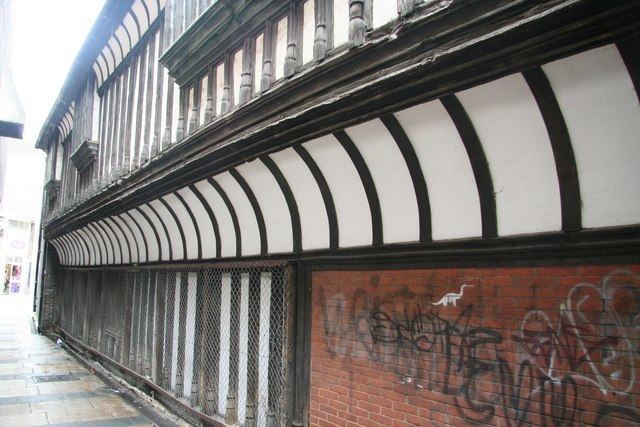OS grid reference SO1392992455 Reference no. 486038 | Built 16th Century Designated as world heritage site 8 October 1953 | |
 | ||
Location In Akrill’s passage, behind the frontage of Uniform Direct, 333 High Street, Lincoln Architectural style(s) Timber framed jettied House | ||
Whitefriar or Akrill's Court in the High Street, Lincoln is an important but sadly neglected timber-framed building. It now has a late 20th century shop front, but the timber-framed building survives with the southern front facing the narrow Akrill’s passage, on the east side of the High Street and just to the south of the railway crossing.
Contents
History
Surprisingly little is known about this building. The name Akrill refers to a baker who owned the property in the early part of the 19th. century. Padley, who made scaled drawings of the buildings in 1851 said that traditionally it was thought to be part of the White or Carmelite Friary in Lincoln. Adjacent to it at the east end was a small stone building with a Norman arch. As the Carmellite friary has now been shown by archaeological excavation to have been under St Mark’s Station, on the opposite side of the High Street, it is unlikely that the building was associated with the friary. It has been alternatively suggested that the Whitefriars was the half-timbered vicarage of St Mary le Wigford church but there is documentary evidence that in 1563 it was owned by Arthur Hall, an important Grantham merchant- this appears to be the same Arthur Hall who was the M.P. for Grantham. The building may have been a speculative commercial, attracting superior tenants who would sell from the ground floor chamber and live with their family on the first floor. Restoration work was undertaken to the building in 1963.
Description
Originally a house dating from the 15th century. The facade faces to the south in a narrow alley-way and the building is at a right angle to the High Street. It has a close studded timber frame of four bays with rendered nogging and a plain tile roof. The first floor is jettied and is coved (curved) outwards with eaves above. South side has moulded uprights. Above, two square wooden oriels on moulded brackets and a 4-light window with wooden mullions and gothic tracery The interior has stud walls with jowled bay posts, two of them with arch braces, and arch braces to the spine beams. Principal rafter roof with collars and spine beam. Two stud walls without nogging.
